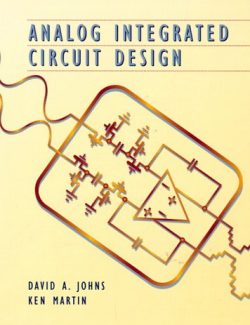Description
In the past two decades, CMOS technology has rapidly embraced the field of analog integrated circuits, providing low-cost, high-performance solutions and rising to dominate the market. While silicon bipolar and Ill-V devices still find niche applications, only CMOS processes have emerged as a viable choice for the integration of today’s complex mixed-signal systems. With channel lengths projected to scale down to 0.03 Am, CMOS technology will continue to serve circuit design for probably another two decades. Analog circuit design itself has evolved with the technology as well.
This book deals with the analysis and design of analog CMOS integrated circuits, emphasizing fundamentals as well as new paradigms that students and practicing engineers need to master in today’s industry. Since analog design requires both intuition and rigor, each concept is first introduced from an intuitive perspective and subsequently treated by careful analysis.
The objective is to develop both a solid foundation and methods of analyzing circuits by inspection so that the reader learns what approximations can be made in which circuits and how much error to expect in each approximation. This approach also enables the reader to apply the concepts to bipolar circuits with little additional effort. I have taught most of the material in this book both at UCLA and in industry, polishing the order, the format, and the content with every offering. As the reader will see throughout the book, I follow four “golden rules” in writing (and teaching): (1)1 explain why the reader needs to know the concept that is to be studied; (2) I put myself in the reader’s position and predict the questions that he/she may have while reading the material for the first time; (3) With Rule 2 in mind, I pretend to know only as much as the (first-time) reader and try to “grow” with him/her, thereby experiencing the same through process; (4) I begin with the “core” concept in a simple (even imprecise) language and gradually add necessary modifications to arrive at the final (precise) idea.













Leave us a comment
No Comments